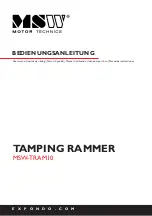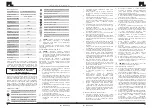
12
13
Rev. 27.06.2022
Rev. 27.06.2022
3.2. PREPARING FOR USE
APPLIANCE LOCATION
Keep the device away from hot surfaces. Always use the
device on an even, stable, fireproof and dry surfaces. Make
sure that the device power supply matches its nameplate
specifications!
Assembling the undercarriage
In order to install the undercarriage transport wheels, the
wheel axle should be installed on the undercarriage hooks.
3.3. DEVICE USE
CAUTION
: Factory new machine is not filled with oil.
Starting the engine without adding oil may damage
the engine and void the warranty.
a)
After unpacking the rammer, check that it has no
visible damage, loose structural components, cuts or
broken plastic parts.
b)
Check the oil level by looking at the oil level sight
glass indicator
d)
Check that the fuel tank valve is closed. Open the fuel
filler cap, check the fuel level and top up the tank with
unleaded petrol if necessary. Close the fuel filler cap.
Ambient temperature
Engine oil standard
+120° F to +15° F (49°C do -9°C)
SAE 30
Below +15° F (-9°C)
SAE 10w-30
Before starting
a)
Check that the structural components are tightened.
b)
Check that the protective accordion does not leak.
c)
Remove any dirt from the flat surfaces of the rammer
and make sure that the handle is clean.
d)
Adjust the handle angle to the operator's height.
Starting the engine
a)
Open the fuel tank valve.
b)
Turn the engine starter switch to the "ON" position.
c) Slightly move the speed control lever to avoid
running the machine at idle speed.
d)
Pull the engine fuel control lever to the fully open
position (maximum to the right).
e)
For a cold start, move the choke lever to the closed
position (maximum to the left), for a warm start the
lever can be in the middle position or fully open.
f) Grasp the starter handle and pull slowly until
resistance is felt. Then pull quickly and vigorously.
After starting, do not release the handle, but put it
back in place.
Caution! Allowing the starter cord to be pulled too quickly
and uncontrollable may cause the user's hand to
be pulled towards the machine before the cord is
released. Unintentional starting may result in injury,
e.g. fracture, bruising, etc.
Adjust the operating speed with the speed control lever.
It is recommended to operate at the highest speed.
g)
If the engine does not start, move the choke lever to
the half-open position (middle position) and repeat
previously described steps.
h)
If the engine does not start after repeated attempts,
check the spark plug for excess fuel. If necessary,
clean or replace the spark plug with a new one.
Stopping the engine
a)
Move the speed control lever to the minimum (idle)
speed and allow the engine to run for approx. 3
minutes at low speed. Then turn the starter switch to
the "OFF" position and close the fuel valves.
3.4. CLEANING AND MAINTENANCE
a)
After cleaning the device, all parts should be dried
completely before using it again.
b)
Store the unit in a dry, cool place, free from moisture
and direct exposure to sunlight.
c)
Do not spray the device with a water jet or submerge
it in water.
d)
The device must be regularly inspected to check its
technical efficiency and spot any damage.
•
After using the rammer
a)
Carefully remove dirt and oil from the engine and the
controls area.
b)
Check and tighten all fasteners.
c)
Check the protective accordion.
•
After a week of use
a)
Remove the fuel filter cover and clean the interior of
the fuel tank.
b)
Remove and clean the filter from the bottom of the
tank.
c)
Remove the spark plug. Check the spark plug and
spark plug washer for wear or damage. Replace
with a new one if necessary. If the spark plug is to
be reused, clean it with a wire brush. Check spark
plug socket. Carefully bend the side electrode, adjust
the gap if necessary. The gap between the electrodes
should be: 0.6-0.7 mm.
ATTENTION: disassembly, replacement and
adjustment of the electrode gap should be done on
a cold engine (cold spark plug)!
d)
Clean the air filter cover.
•
After 200-300 hours of use
a)
Ensure that there is no excess oil on the lubricated
parts. The air filter (X) should be cleaned with
purified kerosene, then immersed in a pre-prepared
bath of engine oil and gasoline in a ratio of 1: 3. Then
squeeze both elements and shake off excess fluid.
b)
Open the air filter cover with the clamp. The air
filter should be cleaned with purified kerosene, then
immersed in a previously prepared bath of engine oil
and petrol in a ratio of 1: 3. Then squeeze both parts
and shake off excess liquid. Put the filter in its place,
close the cover and secure it with the clamp.
c)
Change the hydraulic oil. To remove the old oil, place
a container under the oil outlet. Then loosen the screw
of the hydraulic oil drain hole and tilt the machine to
ease the oil flow. If you continue to use the machine,
fill the tank with MOBIL ISO VG-46 or another oil of
the same standard and properties using a funnel
and observe the oil level on the dipstick. Tighten the
screw.
•
For unlimited storage
a) Remove fuel from the fuel tank, fuel line, and
carburettor.
b) Remove the spark plug and pour a few drops of
engine oil into the cylinder. Grasp and pull the starter
so that the oil reaches all parts of the engine.
EN
EN
c)
If no oil can be seen through the sight glass, top up
the level with ISO VG46 oil or other oil of a similar
standard.
Important: The oil level should be kept at half the
height of the sight glass.
1. Frame
2. Handle
3.
Fuel filler cap
4.
Speed control lever
5. Handle
6. Bellows
7.
Cap 1 with engine oil filler dipstick
8.
Cap 2 with engine oil filler dipstick
9. Inspection window for checking the hydraulic oil
level
10. Foot
11. Axle with wheels
12. Hydraulic oil drain hole
13. Engine starter switch
14. Starter handle
15. Lever regulating the fuel supply to the engine
16. Choke lever
17. Speed control lever
18. Fuel tank valve
e)
Check the engine oil level. Dipstick plugs for checking
the engine oil level are located on both sides of the
machine, both indicate the level in the same tank. If
necessary, top up the oil by inserting the funnel into
the hole. Close the cap with the dipstick.























